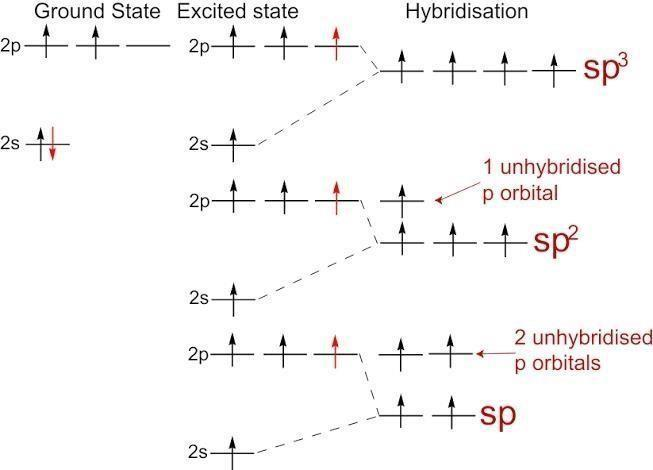
In
A.
B.
C.
D.None of these
Answer
513.9k+ views
1 likes
Hint: Hybridisation is defined as a combination of atomic orbitals to form a new set of equivalent orbitals which are known as hybrid orbitals. When 3 of the p orbitals combine and one s orbital combines it forms sp3 hybridisation. When two p orbitals and one s orbital combines it forms sp2 orbital. When one p and one s orbital combine it forms sp orbital .

Complete step by step answer:
None of these :- as the first option is accurately correct so this option can’t be taken into consideration.
So, the correct answer is Option A.
Note:
Features of hybridisation:-
1.The number of hybrid orbitals is equal to the number of atomic orbitals that get hybridised.
2.The hybridised orbitals are always equivalent in energy and shape
3.The hybrid orbitals are more effective in forming stable bonds than in pure atomic orbitals.
4.Type of hybridisation indicates the geometry of molecule
Conditions for hybridisation:-
1.The orbitals present in the valence shell of the atom are hybridised.
2.The orbitals taking part in hybridisation must have only a small difference of energies.
3.Promotion of electron is not essential condition prior to hybridisation
4.It is not necessary that only half filled orbitals participate in hybridisation.

Complete step by step answer:
None of these :- as the first option is accurately correct so this option can’t be taken into consideration.
So, the correct answer is Option A.
Note:
Features of hybridisation:-
1.The number of hybrid orbitals is equal to the number of atomic orbitals that get hybridised.
2.The hybridised orbitals are always equivalent in energy and shape
3.The hybrid orbitals are more effective in forming stable bonds than in pure atomic orbitals.
4.Type of hybridisation indicates the geometry of molecule
Conditions for hybridisation:-
1.The orbitals present in the valence shell of the atom are hybridised.
2.The orbitals taking part in hybridisation must have only a small difference of energies.
3.Promotion of electron is not essential condition prior to hybridisation
4.It is not necessary that only half filled orbitals participate in hybridisation.
Recently Updated Pages
Master Class 11 Business Studies: Engaging Questions & Answers for Success

Master Class 11 Economics: Engaging Questions & Answers for Success

Master Class 11 Accountancy: Engaging Questions & Answers for Success

Master Class 11 Computer Science: Engaging Questions & Answers for Success

Master Class 11 English: Engaging Questions & Answers for Success

Master Class 11 Maths: Engaging Questions & Answers for Success

Trending doubts
Which one is a true fish A Jellyfish B Starfish C Dogfish class 11 biology CBSE

Difference Between Prokaryotic Cells and Eukaryotic Cells

1 ton equals to A 100 kg B 1000 kg C 10 kg D 10000 class 11 physics CBSE

One Metric ton is equal to kg A 10000 B 1000 C 100 class 11 physics CBSE

How much is 23 kg in pounds class 11 chemistry CBSE

Net gain of ATP in glycolysis a 6 b 2 c 4 d 8 class 11 biology CBSE




